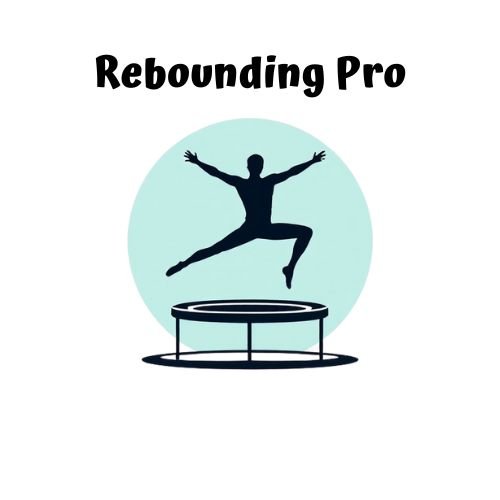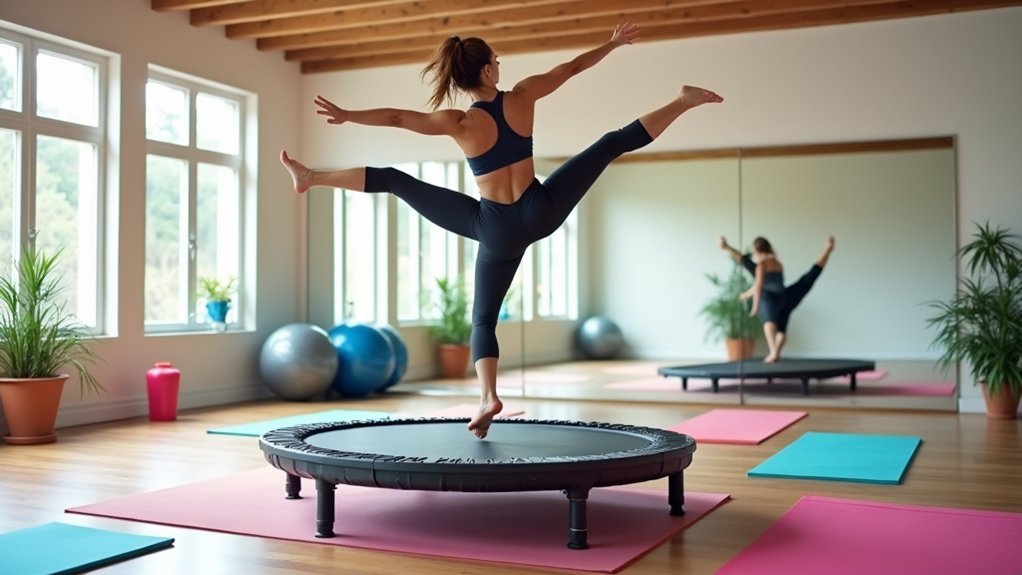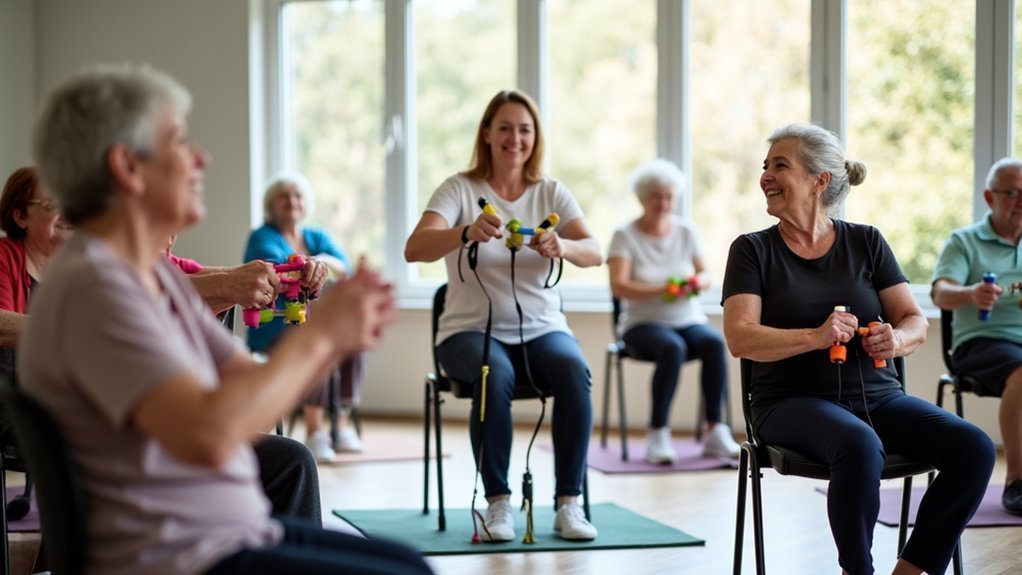Core-firing Pilates trampoline exercises combine controlled instability with rebounding to intensify abdominal engagement while delivering cardiovascular benefits with lower perceived exertion. You’ll need a quality reformer with rebounder attachment and proper form—neutral spine, relaxed shoulders, and engaged abs. Start with beginner sequences like knee drives and modified bounces before progressing to advanced routines with isometric holds and HIIT intervals. This complete guide reveals techniques, progression plans, and recovery strategies to transform your core strength journey.
The Science Behind Core-Firing Trampoline Workouts

While traditional core workouts rely on stable surfaces, trampoline-based Pilates takes advantage of controlled instability to amplify muscle activation throughout your entire midsection. This rebounding effect simultaneously engages your abs, obliques, and lower back as they constantly stabilize your body on the elastic surface.
When you bounce, your pelvic floor muscles activate alongside your core, enhancing bladder control and stability. Your transverse abdominis works overtime to maintain alignment during directional changes. Rebounding on mini-trampolines provides safe individual workouts that are particularly beneficial for adults looking to improve their fitness routine.
Research shows rebounding delivers cardiovascular benefits comparable to running (5-8 METs) but with lower perceived exertion.
The unstable surface also forces multiplanar engagement, challenging your body through lateral and rotational movements. This explains why 8-week programs demonstrate significant improvements in vertical jump height, reactive strength, and core endurance that transfer to everyday activities and athletic performance.
Essential Equipment for Pilates Rebounding
Equipped with knowledge about how trampoline workouts fire up your core, let’s explore the tools you’ll need to maximize these benefits.
The foundation of your practice starts with a quality Pilates reformer featuring a cardio rebounder attachment and adjustable foot bar to accommodate your height and movement range.
For a thorough rebounding practice, consider these essential additions:
- A jumpboard for controlled bouncing and enhanced core stabilization
- Head and neck support pillows to maintain proper cervical alignment during supine exercises
- Spring sets of varying resistance (typically blue for low, yellow for high) to customize intensity
- Non-slip floor pads to prevent equipment shifting during vigorous jumps
Budget-conscious practitioners can start with entry-level reformers ($999) while professionals might prefer premium models with built-in rebounders ($1,300+).
Proper Form and Technique for Maximum Core Engagement

To maximize your core engagement during Pilates trampoline exercises, you’ll need to maintain proper form through a neutral spine position that protects your lower back while activating deep abdominal muscles.
Keep your shoulders relaxed away from your ears, chest open, and pelvis in a balanced position to create the foundation for effective core firing. Focus on scooping abs in toward your rib cage to enhance muscle activation throughout each movement.
Coordinating your breath with each movement—exhaling during the most challenging part of the exercise—will intensify your core activation and help you maintain control on the unstable trampoline surface.
Proper Form and Technique for Maximum Core Engagement
Mastering proper form and technique serves as the foundation for effective core-firing Pilates trampoline exercises. Proper body alignment isn’t just about posture—it directly impacts your core activation and injury prevention.
When on the trampoline, keep your spine neutral and engage your abdominal muscles before initiating any movement. A subtle hip hinge is essential for creating proper core engagement and maintaining stability throughout your exercises.
- Always maintain soft knees to absorb impact while protecting your joints
- Focus on controlled breathing—inhale to prepare, exhale during exertion
- Isolate specific core muscles by consciously activating them throughout each exercise
- Monitor your form continuously, adjusting as fatigue sets in
Remember to prioritize quality over quantity. Even simple movements executed with precision will yield better results than complex exercises performed with poor technique.
Your core engagement should feel deliberate and concentrated, not forced or strained.
Neutral Spine Positioning
Achieving a neutral spine position forms the cornerstone of effective core activation during Pilates trampoline exercises. This position maintains your natural spinal curves—cervical, thoracic, and lumbar—while optimizing shock absorption and reducing stress on your body.
When on the trampoline, verify your pelvis is properly aligned with your ASIS (hip bones) and pubic bone forming a triangle parallel to the floor. Unlike an imprinted spine where you press your back down, neutral spine engages your core without straining spinal extensors.
To find this position, lie on the trampoline with knees bent, engage your transverse abdominis, and make subtle pelvic adjustments until you feel balanced.
Use breathing techniques to maintain stability throughout your exercises, which will enhance core engagement and prevent injury.
Breath Control Essentials
Breath control serves as the cornerstone of effective Pilates trampoline work, functioning as both the engine and stabilizer for core engagement. Your diaphragmatic breathing pattern should align inhalation with rib cage expansion while minimizing abdominal protrusion.
When executing movements, coordinate your exhale with peak exertion phases using lateral breath mechanics rather than upper chest breathing.
- Use nasal inhales followed by controlled mouth exhales to optimize oxygen exchange
- Create “audible exhalation” (like an “sss” sound) during challenging phases to enhance core activation
- Practice rhythmic percussive breathing (5 short inhales/exhales) during high-intensity rebounding sequences
- Maintain continuous airflow to prevent breath-holding and the Valsalva maneuver
This breath-movement synchronization not only improves oxygen efficiency for better endurance but also provides essential spinal stabilization during dynamic trampoline work.
Beginner-Friendly Core Rebounding Sequences

Start with fundamental jump basics to develop proper alignment before attempting more complex core exercises.
Your five-minute core circuit should include knee drives and modified bounces, gradually building to air bikes as you gain confidence.
Remember that maintaining stability through proper posture trumps speed when you’re first learning rebounding techniques. Position your feet wider than hips with a slight knee bend to establish proper foundation and maximize core engagement during basic bounce movements.
First Jump Basics
Before stepping onto the trampoline for your first rebounding session, you’ll need to master a few fundamental basics that create the foundation for all Pilates-based trampoline work.
Position your feet hip-width apart with slightly bent knees to absorb impact while maintaining neutral pelvic alignment. Keep your hands near your hips or hold the frame for initial stability.
Start with small movements before progressing to full rebounds:
- Begin with 1-2 inch gentle pulses to acclimate your body to the surface
- Practice the “march in place” drill to initiate core engagement
- Try heel-toe rocking motions to activate your transverse abdominis
- Focus your gaze forward to prevent dizziness and maintain proper cervical alignment
Remember to synchronize your breathing—inhale as you rise, exhale as you land, maintaining rib cage containment throughout.
Five-Minute Core Circuit
A simple five-minute core circuit offers the perfect introduction to Pilates trampoline training without overwhelming newcomers.
Begin with a gentle health bounce, keeping your core engaged and breathing steady throughout the movement. Be sure to maintain a micro bend in knees with your navel drawn back to spine for proper form.
For your circuit, perform each exercise for 30 seconds before shifting:
- Basic bounce with engaged abdominals
- Foot-planted bounce focusing on stability
- Controlled arm raises while maintaining core tightness
- Gentle leg lifts that activate lower abdominals
- Modified roll-ups for upper abdominal strength
This fast-paced sequence boosts energy and circulation while building fundamental core strength.
If you’re feeling unsteady, don’t hesitate to use a stability bar for support.
Remember that controlled movements yield better results than rushed ones—you’ll develop proper technique that you can build upon as your confidence grows.
Stability Before Speed
Building on that foundation circuit, stability must precede speed when working with a Pilates trampoline. Master basic stabilized bounces before attempting dynamic movements. The rebounder’s elastic surface demands proper core engagement first, not momentum.
Start with heel-driven rebounds to activate your posterior chain while maintaining a neutral spine. Progress gradually through controlled breath patterning—inhale down, exhale up—to enhance intra-abdominal pressure and core protection. Low-impact exercise is ideal for protecting your joints while still getting an effective workout.
- Practice static holds at the bottom of your bounce to build neuromuscular coordination
- Incorporate front-back weight shifts without leaving the surface
- Use pulsed mini-bounces (1-inch movements) with bent knees for constant tension
- Add arm sweep integration with slow, controlled movements to challenge rotational stability
Advanced Core-Firing Routines for Experienced Rebounders
Once you’ve mastered basic rebounding techniques, your body is ready for the intensified core challenges that advanced trampoline Pilates can deliver.
Incorporate isometric holds like V-sits with controlled roll-ups to target deeper abdominal layers.
Elevate your practice with 45-second work/15-second rest HIIT cycles using three-round structures of eight exercises.
Try adding light hand weights during rebounds to force your core to counterbalance momentum.
Progress by implementing unilateral movements and eyes-closed balancing to heighten proprioceptive engagement.
Alternate low-to-ground pulses with full-height jumps to vary core load.
Always maintain centered rebounds to prevent mat-edge instability, and consider going barefoot for ideal feedback.
Remember to synchronize your breathing—inhale through nose, exhale through mouth—to enhance intra-abdominal pressure during challenging sequences.
Advanced rebounders can progress to the teasers with arm pumps for an intense core activation while maintaining proper form throughout the movement.
Combining Pilates Principles With Trampoline Exercises
To maximize your trampoline-Pilates fusion, you’ll need to master three essential principles that transform ordinary bouncing into powerful core work.
Control each movement with precision, keeping your form exact even as the trampoline creates instability and resistance.
Remember to activate your powerhouse (deep abdominal muscles) before initiating any movement, and coordinate your breath with each action—inhale to prepare and exhale during the most challenging phase of movement.
Precision Through Controlled Movement
While traditional trampoline workouts often emphasize height and momentum, Pilates-based rebounding demands meticulous attention to form and alignment.
You’ll need to maintain neutral spine positioning throughout each movement, preventing lumbar strain even during dynamic sequences. The key lies in controlled deceleration—your eccentric muscle control reduces impact forces by up to 80% compared to hard-surface exercises. This approach is especially beneficial as it provides a low-impact alternative for individuals seeking effective exercise without stressing their joints.
- Practice micro-bounces (small pulsations) to train proprioception while maintaining proper form
- Engage your hip flexors during squats and jumps to prevent anterior pelvic tilting
- Focus on ribcage closure technique to maintain thoracic alignment during propulsion
- Incorporate lateral costal breathing to oxygenate muscles throughout high-intensity sequences
These precision techniques transform ordinary rebounding into a sophisticated movement practice that amplifies core activation.
Core Engagement Fundamentals
The foundation of effective trampoline Pilates lies in mastering proper core engagement techniques. Your power center includes not just abdominals but also back, pelvic, and hip muscles that must work in unison for stability and strength.
Begin by activating your core through isometric contractions while maintaining proper alignment on the trampoline’s unstable surface. This challenges your stabilizing muscles in ways traditional Pilates can’t match.
When executing movements, focus on initiating from your center while maintaining neutral spine positioning. The trampoline’s bounce and flexibility further challenges your balance and coordination, making your core work harder to maintain stability during exercises.
For effective engagement, imagine drawing your navel toward your spine while breathing normally. Don’t hollow completely—instead, maintain tension that supports your posture without restricting movement.
This balanced activation prevents injury while maximizing the benefits of combining Pilates principles with trampoline exercises.
Breath-Body Connection
Mastering the breath-body connection transforms ordinary trampoline workouts into powerful Pilates-infused training sessions.
By synchronizing your breathing with each bounce and movement, you’ll experience greater control, deeper core engagement, and enhanced mindfulness during your practice.
Diaphragmatic breathing—drawing air deep into your abdomen rather than shallow chest breathing—serves as the foundation for this integration.
As you coordinate your inhales and exhales with specific movements, you’ll create a rhythmic flow that maximizes efficiency and reduces injury risk.
- Inhale during preparation phases to create length and space in your body
- Exhale during effort phases to activate your core and stabilize movements
- Practice consistent breathing patterns during bouncing to maintain balance
- Use post-exercise deep breathing to accelerate recovery and release tension
Core Stabilization Techniques on the Rebounder
Understanding core stabilization on a rebounder transforms traditional Pilates into a dynamic challenge unlike any mat-based workout. The unstable surface constantly engages your core as your body continuously adjusts to maintain balance.
Begin with foundational drills like micro-bounces and pelvic tilts to activate your transverse abdominis. Single-leg balance holds and marching in place develop essential stability before advancing to dynamic movements. Performing exercises with 40 seconds of effort followed by 15-second transitions creates an effective interval training format.
When you’re ready, progress to knee drives, controlled kicks, and rotational jumps that challenge your core from multiple angles.
Watch for common mistakes: keep your spine neutral by drawing ribs toward hips, maintain controlled bounce height, and remember to breathe with each movement.
For ideal results, position yourself at the center of a bungee-based rebounder and wear grip socks to enhance stability during lateral movements.
Progressive Training Plans for Core Strength Development
Developing core strength on a rebounder requires a strategic, phase-based approach that builds systematically over time. Your training should follow the fundamental progression principles, moving from stability to strength and finally to power development.
Core training on a rebounder demands systematic progression—master stability before advancing to strength, then power development.
Begin with the stabilization phase to establish proper form before advancing to more dynamic movements. As you progress, incorporate varied equipment like resistance bands or medicine balls to challenge your core from different angles. Skipping the stabilization phase can result in impeded performance and potential injury during more advanced exercises.
- Start with basic exercises in all three planes of motion (sagittal, frontal, and transverse)
- Add resistance gradually through bands, weights, or increased bounce height
- Incorporate sport-specific movements that target your individual goals
- Vary your speed and tempo to develop both stability and power components
Common Mistakes to Avoid During Rebounding Core Work
Despite its apparent simplicity, effective core work on a rebounder requires proper form and technique to maximize results while preventing injury.
Avoid locking your knees or falling into anterior pelvic tilt, which disengages core muscles and risks back strain.
Don’t hunch your shoulders or position your head forward, as this disrupts the core-spine connection. Keeping shoulders down and back helps maintain proper upper body alignment during rebounding exercises.
Maintaining a neutral spine with micro-bends in your knees is essential for proper shock absorption.
Watch for overarching your back during jumps instead of “zipping up” your core.
Avoid vertical-only movements; incorporate multidirectional bounces to engage your obliques.
Remember that heavy landings indicate poor eccentric control from your core muscles.
Don’t rush through exercises—proper core muscle sequencing requires controlled tempo.
Always maintain hip-width stance for ideal core recruitment.
Measuring Your Progress: Core Strength Milestones
Tracking your core development on the Pilates rebounder requires specific metrics that go beyond simple appearance changes. As you progress, you’ll notice improvements in both form retention and functional capacity that indicate genuine strength development.
Monitor these key progress indicators:
- Time under tension – You’ll gradually maintain core engagement for 20-30% longer during exercises without fatigue.
- Neutral spine mastery – Aim to hold proper alignment for 90% of your workout without lumbar arching.
- Movement complexity – Your ability to advance from basic bounces to integrated rotational patterns.
- Recovery efficiency – Notice how quickly your heart rate returns to baseline after intense rebounding sequences.
The low-impact nature of trampoline workouts makes it easier to track true strength gains without joint pain masking your progress.
Document these milestones systematically, celebrating each improvement as evidence of your strengthening core foundation.
Tailoring Rebounding Workouts for Different Fitness Goals
Now that you can track your progress effectively, let’s explore how to customize your rebounding practice for specific outcomes. Your fitness goals will determine which trampoline exercises serve you best.
For weight management, incorporate HIIT sessions that maximize caloric burn while protecting your joints. If you’re focused on building endurance, gradually increase workout duration and intensity through progressive overload.
Those recovering from injuries can benefit from gentle, low-impact bounces that strengthen without strain. Beginners should start with simple health bounces at varying tempos, while intermediate rebounders can add dance or barre elements for increased challenge.
If you’re advanced, try complex jumping sequences that test both strength and coordination. Remember that consistency is key—regular trampoline sessions contribute to improved metabolism, bone density, and stress management regardless of your specific goal. These exercises engage multiple muscle groups simultaneously, making them an efficient full-body workout option.
Recovery Strategies for Optimal Core Development
While perfecting your core-firing trampoline exercises, incorporating effective recovery strategies becomes essential for maximizing results and preventing injury. Your core muscles need proper recovery time to rebuild stronger while maintaining functional stability throughout your training cycle.
Combine these research-backed recovery approaches for superior core development:
- Schedule 45-second rebound intervals with 75-second rest periods to clear lactate without overloading muscles.
- Pair gentle trampoline oscillations with diaphragmatic breathing techniques to activate the parasympathetic system and reduce cortisol levels.
- Implement fascial rebound techniques (rapid gentle pulses) to stimulate lymphatic drainage and enhance circulation to core tissues.
- Utilize rebound-assisted pelvic tilts and rocking motions between workouts to improve spinal articulation and release tension.
Frequently Asked Questions
Can Trampoline Workouts Help With Specific Back Problems?
Yes, trampoline workouts can help with specific back problems by strengthening core muscles, reducing joint strain, improving bone density in osteopenia, and providing low-impact rehabilitation for injured backs. Always consult your doctor first.
How Often Should I Replace My Rebounding Trampoline?
Replace your rebounding trampoline mat every 3-5 years, depending on usage. Check it monthly for tears or sagging. Springs need replacement every 3-5 years if rusted or stretched. Annual thorough assessments are recommended.
Are These Exercises Safe During Pregnancy?
Trampoline exercises during pregnancy require caution. You’ll need your doctor’s approval first. While low-impact rebounding offers benefits, you should modify movements, avoid bouncing, and skip traditional core exercises as your pregnancy progresses.
Can Children Benefit From Core-Firing Trampoline Exercises?
Yes, your children can greatly benefit from trampoline exercises. They’ll develop stronger muscles, better coordination, enhanced cognitive skills, and improved social abilities while having fun bouncing and learning new movements.
How Does Rebounding Compare to Traditional Mat Pilates?
Rebounding offers more cardiovascular benefits and dynamic movement than mat Pilates. You’ll burn more calories on a trampoline while still engaging your core. Mat work emphasizes controlled movements and uses minimal equipment.
In Summary
You’ve now explored the powerful world of core-firing Pilates trampoline exercises. By incorporating these dynamic rebounding techniques into your fitness routine, you’ll strengthen your core, improve balance, and boost cardiovascular health simultaneously. Remember to start with proper form, progress gradually, and listen to your body. Whether you’re a beginner or advanced rebounder, you’ll continue to discover new challenges as your core strength evolves.





Leave a Reply